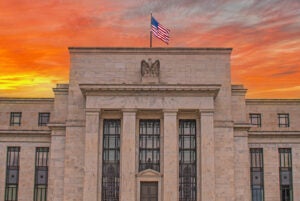How would credit card issuers react to a recession?

An economic hurricane is coming, according to JPMorgan Chase CEO Jamie Dimon. In fact, nearly all U.S. CEOs (98 percent) recently surveyed by The Conference Board say they are preparing for a recession within the next 12 to 18 months.
Our latest Bankrate survey of leading economists posed the question slightly differently. Panelists believe there is roughly a two-in-three chance of a recession within the next 12 to 18 months.
As dour as all of that sounds, we did get some positive news when the third-quarter GDP reading came in 2.6 percent higher than the previous quarter, breaking a string of two straight small declines to start the year. That quieted the debate concerning whether or not we’re already in a recession (which already seemed dubious given that the unemployment rate currently matches the lowest level in a half-century and consumer spending has been robust).
Nonetheless, as Dimon put it, storm clouds are gathering. There is widespread agreement that a recession is likely in 2023 or early 2024. Many observers feel that a recession is the only logical outcome of the Federal Reserve’s quest to lower the highest inflation readings in 40 years with an aggressive series of interest rate hikes.
What this means for credit card users
The average credit card rate has jumped from 16.30 percent at the start of the year to 18.73 percent at present. That’s the highest it has been since Feb. 1992. The average will almost certainly blow past the all-time record of 19.00 percent very soon. Making matters worse for anyone who carries a balance, these increases have come at an unusually rapid pace.
If you don’t have credit card debt, these rate hikes won’t affect your credit card bill. In other words, if you pay in full at the end of your billing cycle each month, your bill won’t include interest payments — so an increased APR doesn’t impact you.
But if you’re one of the many who do carry a credit card balance from month to month, these rate hikes can significantly increase your debt burden.
Let’s say you owe $5,000 in credit card debt.
- If you make minimum payments at 16.30 percent, you’ll be in debt for 185 months and will end up paying a total of $5,517 in interest.
- At 18.73 percent, those minimum payments will keep you in debt for 190 months, and you’ll owe $6,422 in interest ($905 and 16 percent more than the former scenario).
Credit card balances are setting records, too. Equifax says total card balances are $916 billion, a 23 percent jump since April 2021.
Higher rates, higher balances and inflation are a nasty combination. Credit card debt was already a persistent problem for many households and it’s getting worse. Bankrate found that 60 percent of credit card debtors have been in debt for at least a year, up from 50 percent a year ago.
The silver lining so far
Credit card delinquencies and defaults have remained very low. Just 1.81 percent of credit card balances were 30 or more days past due as of Q2 2022, according to the Federal Reserve. Chargeoffs (delinquencies so severe that the card issuer has essentially given up on ever getting the money back) only weighed in at 1.97 percent. Delinquencies and defaults have ticked up a little bit in recent months, but they’re still well below historical norms. For comparison, those figures were 2.63 and 3.65 percent respectively in Q4 2019.
In fact, normalization is a word that came up time and time again during banks’ recent earnings calls. The financial industry’s prevailing viewpoint, at least for now, is that delinquencies and defaults will continue to rise slowly, but not to worrisome levels. The feeling seems to be that these statistics were artificially low in 2020 and 2021 as many consumers paid off debt with their stimulus payments and spent less due to pandemic concerns.
This year, the credit card industry has been able to have its cake and eat it too. Consumer spending has roared back as COVID-19 has retreated, yet almost all customers are paying their bills on time. Still, storm clouds are gathering.
Credit card issuers are bolstering their reserves to guard against potential credit losses in the future. And while they’re not tightening their lending standards on a broad scale, they’re not loosening them, either. The Fed’s Senior Loan Officer Survey found that 95.7 percent of credit card issuers kept approval standards more or less unchanged in the latest quarter. At the moment, cautious optimism is mixing with emergency preparedness.
How bad will the economy get?
Fortunately, there’s a good chance that the next recession will be a mild one, at least compared with the past two. During his company’s Oct. 25 earnings call, Discover CFO John Greene outlined a “more optimistic” scenario in which the unemployment rate rises only slightly, from 3.5 percent now to approximately 4 percent. He also referenced “a dark scenario” that would push the rate “north of 6 percent.” In comparison, the unemployment rate hit double digits in 2009 and 2020.
Let’s be clear: Recessions are never fun, and more than four million Americans would likely lose their jobs if the unemployment rate were to rise to 6 percent. We’re not rooting for that to happen, nor would we minimize the pain that would be associated with that. But it’s also important to note that a recession doesn’t necessarily have to mean a full-blown crisis akin to the Great Recession of 2007-09 or the COVID-19 pandemic which began in early 2020.
The financial system is currently stable. Much tighter regulations were imposed after the financial crisis and all major banks are well capitalized. The next recession could manifest more as a corporate profit slowdown and less as a Main Street panic.
For now, credit card issuers are mostly staying the course
There haven’t been as many notable credit card launches or refreshes this year as there were last year, but originations are still at an all-time high. Through July, Equifax says they were up 17.2 percent from last year’s record pace. The average credit limit for a newly-issued credit card is $4,955. That represents a 20 percent leap from $4,131 last year. It’s still down, however, from the 2019 average ($5,284).
About one in five of the new cards (20.5 percent) opened this year went to someone with a subprime credit score. While that marks a slight dip from 22.3 percent last year, lenders have continued to exhibit a sizable appetite for new customers with less than pristine credit. In 2019, 20.0 percent of new credit cards went to subprime consumers.
This year, competition has been especially intense among balance transfer cards, with Bank of America joining Wells Fargo and Citi in offering intro APR balance transfer promotions lasting up to 21 months.
The travel and cash back spaces certainly haven’t been forgotten, either. The Chase Sapphire Reserve®, which is one of the most popular travel cards, recently upped its welcome bonus to the highest level since 2016. And the Citi® Double Cash Card, a favorite among cash back enthusiasts, is offering an introductory bonus to all new cardholders for the first time (it used to only give the bonus to select, targeted individuals).
Capital One CEO Richard Fairbank summed it up nicely during his latest earnings call: “Generally, in the card business, competition continues to be high, but largely stable and rational over the past few quarters.”
The bottom line
If and when the economy takes a turn for the worse, it’s logical to expect that the first cutbacks will be targeted at people with lower incomes and lower credit scores. They’re riskier borrowers, so it makes sense. Those people could find it harder to access credit.
We would probably also see card companies cut back on marketing expenses, including sign-up bonuses, but the K-shaped economy is such that these deals are unlikely to come to a standstill. Barring a full-blown crisis, there should still be ample demand for new customers who spend a lot of money and pay their bills on time.
The credit card industry currently has a lot of momentum. The continued rise in e-commerce and the decline of cash are tailwinds. That’s especially true when you factor in the release of pent-up demand for travel, dining and other experiences as COVID-19 has evolved. Elevated consumer spending and minimal delinquencies may not last forever, but I’m still optimistic about the credit card industry’s near- and long-term futures.
Have a question about credit cards? E-mail me at ted.rossman@bankrate.com and I’d be happy to help.
Why we ask for feedback Your feedback helps us improve our content and services. It takes less than a minute to complete.
Your responses are anonymous and will only be used for improving our website.






